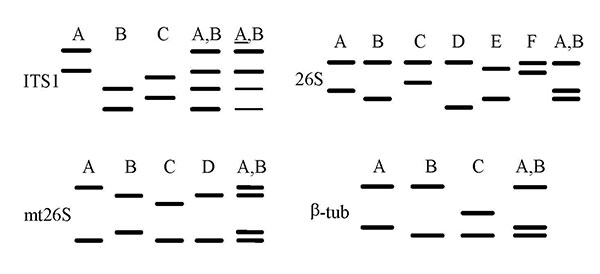Volume 10, Number 10—October 2004
Perspective
Strain Typing Methods and Molecular Epidemiology of Pneumocystis Pneumonia
Figure 1

Figure 1. Schematic representation of the single-strand conformation polymorphism (SSCP) patterns of four variable regions used to type Pneumocystis jirovecii. Each lane corresponds to a hypothetical sample. All simple patterns with two bands for each region are shown. Each uppercase letter represents a simple SSCP pattern. For each region, the complex SSCP pattern A,B corresponding to the superimposition of simple patterns A and B is represented. The complex ITS1 pattern A,B, is demonstrated, in which pattern A is more abundant than pattern B.
Page created: March 30, 2011
Page updated: March 30, 2011
Page reviewed: March 30, 2011
The conclusions, findings, and opinions expressed by authors contributing to this journal do not necessarily reflect the official position of the U.S. Department of Health and Human Services, the Public Health Service, the Centers for Disease Control and Prevention, or the authors' affiliated institutions. Use of trade names is for identification only and does not imply endorsement by any of the groups named above.